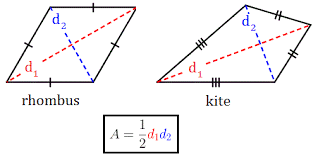How do you verify that parallelogram ABCD with vertices A(-5. -1), B(-9, 6), C(-1. 5). and D(3,-2) is a rhombus by showing that it is a parallelogram with perpendicular diagonal?
1 Answer
Hence it’s a
Explanation:

Properties of a rhombus :
a) opposite sides are parallel. b) All the four sides are equal.
c) Diagonals bisect each other at right angles.
If AB // CD, BC // AD, it’s a parallelogram.
If slope of AB = CD, BC = AD then it’s a parallelogram.
Hence AB // CD, BC // AD and ABCD is a parallelogram
Slope of AC
Slope of BD
Hence diagonals intersect each other at right angles.
It can be a square or a rhombus or a kite.
It’s not a square since AB not perpendicular AD.
It can be a rhombus or a kite.
If the intersection point of the diagonals is their midpoint, then it’s a rhombus, else it’s a kite.
Let’s find the mid point (E) of AC & BD to prove it’s a rhombus.
Also
Hence it’s a
